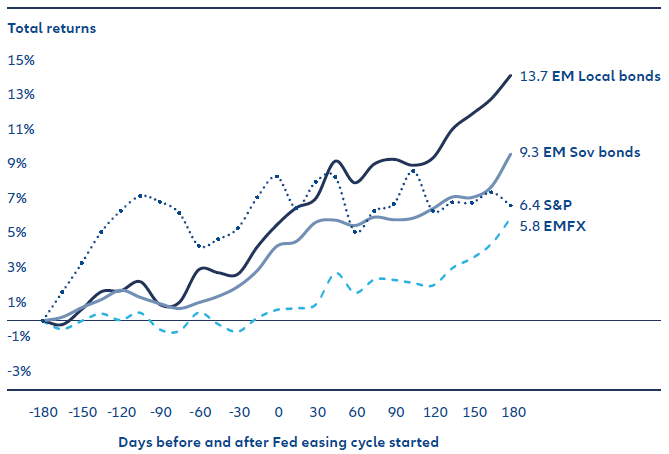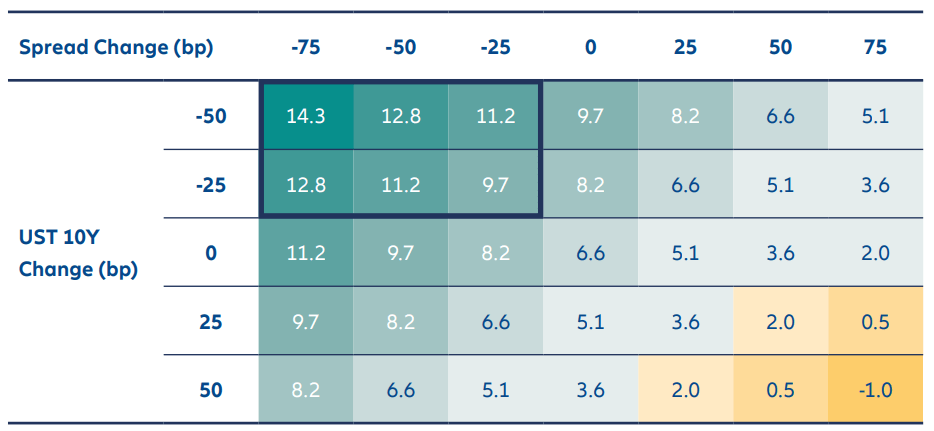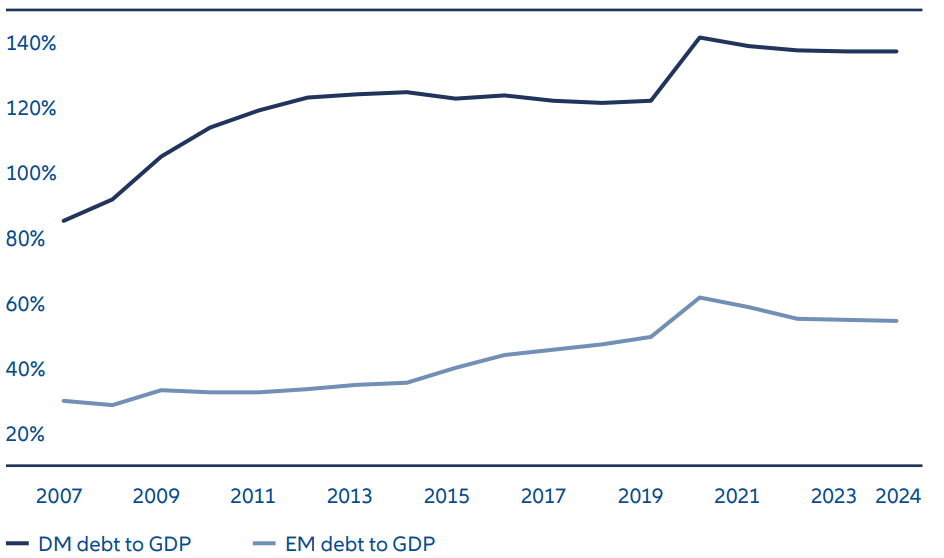Navigating Rates
Bullish outlook for EM debt in 2025 – but mind the volatility

Investors in emerging market (EM) debt face several challenges in 2025, such as tighter spreads with US Treasuries and the implications of tariffs and potential trade wars. But we still expect a year of opportunities for those who can look beyond the volatility.
We think the return of Donald Trump to the White House could bring turbulence to emerging market (EM) debt. On top of this, the economic environment gives EM central banks little room for policy easing. But despite downward revisions, we believe the prospects for GDP growth across EM countries are resilient. Moreover, the yields on some EM bonds with solid credit quality may be large enough to cushion investors against unpredictable moves in US Treasury yields. Overall, this could be a good year for EM debt – so long as investors can ride out volatility. Here’s our review of the potential opportunities and challenges for this asset class in 2025.
Opportunity: EM political risks lower in 2025 now key elections are over
Last year, roughly 2 billion people went to the polls, making it the busiest election year ever.1 This naturally added significant volatility to markets. In the United States, the electoral race was tight until the last minute, with the approach to international policy being very different for candidates Donald Trump and Kamala Harris. The Mexican election showed larger-than-expected support for President Claudia Sheinbaum, with the markets pricing-in risks of institutional deterioration after her Morena party and its allies obtained a super-majority in Congress. South African elections proved to be a good investment opportunity; after markets sold-off into the event, the African National Congress (ANC) negotiated a successful coalition with the opposition following worse-than expected polling, which led to a unity government not originally anticipated by the consensus. Finally, the outcome of elections in India delivered policy continuation for Prime Minister Narendra Modi. Heading into 2025, the election calendar is much less busy, which, we believe, removes a significant layer of uncertainty for emerging markets.
Challenge: US tariffs may be on the way
A key challenge for EM debt in 2025 is the potential for US tariffs, as we see no reason for Mr Trump to moderate his confrontational stance as president. His campaign rhetoric has worked well in gaining votes and several of his cabinet choices seem to favour the “America first” approach. That said, for countries such as Mexico and Canada, the discussion may be more focused on immigration than on a specific economic negotiation – as a reminder, Mr Trump already negotiated the North American Free Trade Agreement (NAFTA) into the United StatesMexico-Canada Agreement (USMCA) in his last administration. This focus on immigration may imply that although headline risks will remain high, the economic implications of Trump 2.0 may be less impactful than many anticipate. It is also important to keep in mind that emerging markets generally did well during the last Trump administration.2
Opportunity: Past interest rate cycles were supportive for EM debt
Industry estimates suggest that about three-quarters of the funding of EM debt positions is USD-denominated. Although the US Federal Reserve (Fed) has scaled back its programme of rate cuts, the US policy rate is still on a downward trend, which implies cheaper funding for most EM positions, in addition to pulling yields structurally lower (albeit with some steepening of the yield curve). This should improve prospects for duration, or interest rate risk. Exhibit 1 shows the average performance of key EM benchmarks over the Fed’s last two easing cycles – in 2007 and 2019. On average, EM local bonds (proxied by the J.P. Morgan GBI-EM Global Diversified index) delivered 13.7% returns during the 12-month period beginning six months before the first rate cut. Similarly, EM sovereign bonds (proxied by the J.P. Morgan EMBIG Global Diversified) delivered 9.3% returns – higher than the S&P 500 return of 6.4% on average. The current cycle is likely to be shallower than the prior two: the 2007 cycle saw the subprime mortgage crisis and the housing bubble burst, which led to decisive Fed action, and the 2019 easing cycle was driven by Covid-19. Nevertheless, the Fed’s commitment to ease rates is supportive.
Exhibit 1: Returns in the 12 months spanning the start of the Fed’s rate-cutting cycle (2007 and 2019)

Average emerging market performance for the cycles starting on 18 September 2007 and 31 July 2019, using for EM performance the returns of J.P. Morgan EMBIG GD and GBI-EM. JPM EMBIG GD: J.P. Morgan Emerging Markets Hard Currency bond index. JPM GBI-EM: J.P. Morgan Emerging Markets Local Currency Index.
Source: Allianz Global Investors, Bloomberg, as of December 2024.
Challenge: Markets could punish fiscal expansion
On the other hand, markets are closely scrutinising fiscal dynamics and are likely to penalise countries that are pursuing fiscal expansion. One of the best-performing EM fixed income bonds in 2024 was Argentina, which delivered a positive surprise by achieving nine consecutive months of fiscal surplus. In contrast, countries such as Panama, Brazil and Romania delivered negative fiscal surprises amid overall expansive budgets, and their bonds performed poorly, particularly local bonds. We believe this investment theme will continue, with investors scrutinising fiscal dynamics and punishing those countries with deteriorating long-term debt to GDP
Opportunity: Emerging market GDP resilient despite downward revisions
Bloomberg consensus estimates for 2025 GDP growth for 34 key EM countries are at a solid 3.4%. Importantly, these estimates already incorporate several downward revisions, particularly after Mr Trump won the US election and markets priced in higher US policy uncertainty. We think this overall figure is strong enough to maintain positive investor sentiment in 2025 and note that a detailed breakdown of GDP shows that consumption levels have remained firm across many countries or regions. On China, our view is that the recent stimulus measures are enough to avoid a sharp deceleration in growth, even if the measures disappointed some analysts in terms of size and impact.
Exhibit 2: Estimated GDP growth for emerging markets in 2025

Source: Bloomberg consensus estimates, January 2025.
Challenge: Inflation is no longer trending lower and central banks have limited room to ease
The less good news is that inflation is likely to be a key challenge for 2025. In the aggregate, headline inflation is no longer trending lower, and there are risks in some emerging countries that currency weakness will lead to a rise in the cost of imports and an accompanying rise in the consumer price index. US tariff risks put EM central bankers in an uncomfortable position, suggesting limited room to ease policy relative to the start of last year. This does not mean that EM central banks must turn hawkish yet, but we think central bank prudence will be important in 2025, with limited space for EMs in general to cut rates.
Opportunity: High yields imply an attractive carry
Yields from EM bonds are generally high, with bonds from solid BBB-rated issuers yielding above 6%.3 This ranks in the 95th percentile of the last 10 years’ data. Admittedly, the spread between EM yields and “risk-free” US Treasury yields is tight, but we nevertheless think that the bond carry – ie, the profits derived by holding a bond over time – is large enough to provide a cushion against possible spread widening, or a bond sell-off. Exhibit 3 shows the breakeven analysis of a portfolio of EM sovereign bonds, with the outlier being that 75 basis points of spread widening plus a 10-year US Treasury selloff of 50 basis points would be required for EM investors to incur losses, given the current high carry environment.
Exhibit 3: Breakeven analysis of EM sovereign bonds

Only at the extreme scenario of greater than 75 basis points (bp) spread widening and US Treasury
(UST) widening by 50bp would EM hard currency returns be negative – see bottom right of the chart.
The box highlighted in the top left indicates our expectation for more realistic outcomes.
Source: Allianz Global Investors, J.P. Morgan, as of December of 2024
Challenge: The yield spread between EM debt and US Treasuries is a concern
That said, spreads between EM yields and US Treasury yields are undeniably tight compared with the past decade.4 Some investors may be concerned the narrow spreads imply investors are not being adequately compensated for the risks involved with holding EM debt. We would argue, however, that given the macroeconomic improvement in EM fiscal dynamics seen over recent years, some spread tightening is fundamentally driven and is here to stay. This can be seen in Exhibit 4, which shows emerging and developed market debt-to-GDP over the years. The EM debt-to-GDP trajectory is better than developed markets, not only exhibiting an overall lower level, but also showing a larger post-Covid improvement. In other words, some emerging markets have done a good job of keeping their fiscal balances in check, and in our view tighter spreads are likely permanent.
Exhibit 4: Emerging markets have less debt than developed markets

Source: Allianz Global Investors, World Economic Outlook data with J.P. Morgan EMBIG weights for the EM average and simple average for developed markets (DM) of US, UK, Eurozone, Japan.
As of February 2024.
A volatile year, but ripe with potential opportunity
We think the return of tariffs and trade wars to the political agenda is likely to bring unpredictability to EM debt in 2025. Inflation concerns may also limit EM central banks’ room for manoeuvre. That said, history can teach us an important lesson: EM fixed income investments did well during the last Trump administration, at least until Covid-19 hit. The asset class delivered positive returns even after NAFTA was renegotiated into USMCA, and despite China and the US sparring over trade tariffs. We think prospects for emerging market GDP growth are resilient in 2025 and note that political risks have fallen following the flurry of elections in 2024. Overall, we see a promising outlook as long as investors can weather any turbulence.
1 World Economic Forum - 2024 is a record year for elections. Here’s what you need to know
2 Key indices such as the J.P. Morgan EMBIG and J.P. Morgan CEMBIG outperformed US IG (Investment Grade) and US HY (High Yield) over the 2016 to 2019 period, before the Covid-19 selloff started. Source: Bloomberg, J.P. Morgan, as of December 2024
3 Based on the J.P. Morgan EMBIG Global diversified index for BBB-rated bonds. Source: Bloomberg, J.P. Morgan, as of December of 2024.
4 The sovereign spread plotted by the J.P. Morgan EMBIG Global Diversified index is about 50 basis points tighter than the past 10-year average. Source: Bloomberg, J.P. Morgan, as of December of 2024
4173025







